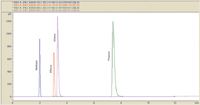An Alternative Method to RSK 175 Using a Purge and Trap Concentrator and GC–FID
Due to increased concern over the hydrofracturing process and the release of methane and other chemicals into the local drinking water, a need has developed for fast and accurate analysis of methane in water.
Due to increased concern over the hydrofracturing process and the release of methane and other chemicals into the local drinking water, a need has developed for fast and accurate analysis of methane in water. This application note will evaluate a method developed for the determination of light hydrocarbons in water using automated Purge and Trap concentration: PA DEP 9243 - Light Hydrocarbons in Aqueous Samples via Purge and Trap GC–FID (1).
Hydraulic fracturing, also known as "fracking," is a drilling process currently used to recover natural gas from sources like coalbeds and shale formations. This involves injecting large amounts of water, mixed with sand and chemicals, at high pressures to break up the shale to release the gas. Natural gas from these hard-to-extract sources is becoming increasingly popular and is projected to grow to nearly 45% of the nation's natural gas supplies by 2035.
A common method for determining natural gas constituents in water is RSK 175 (2), which uses headspace equilibration to determine the concentration of analytes. Building upon this manual technique, automated headspace methods such as PA-DEP 3686 (1), have been developed by the Pennsylvania Department of Environmental Protection. With a lack of EPA methods requiring headspace analysis, these instruments are not normally found in environmental laboratories. This application demonstrates using a purge and trap concentrator, which are commonplace due to EPA regulations on VOCs in water and soil.
For this study, a Stratum PTC was used in conjunction with an AQUATek 100 Autosampler. This set-up allows for complete automation of sample preparation for the analysis of liquid samples for purge and trap. A recirculating chiller bath was also utilized to maintain a sample temperature of less than 10 °C.
Utilizing a GC–FID, a linear calibration was performed and %RSD and MDLs were determined for all compounds.
Calibration Data
To make the stock solutions, a 500 mL volumetric flask filled with de-ionized water was placed in an ice water bath and purged with a reference gas corresponding to each analyte. Each gas was bubbled through chilled water for 2 h to make individual concentrated standards. Unlike in RSK 175 (2), the PADEP methods require aqueous rather than gaseous standards. Calibration standards were made from serial dilutions of these stock standards by calculating the concentration of saturated gas solutions in water at known temperatures.

Figure 1: Overlay chromatogram of gas standards.
The calibration data was evaluated for linearity and %RSD. MDLs were also established for all compounds by analyzing seven low level replicates. An overlay chromatogram for all reference standards can be found in Figure 1. A blank analyzed after the highest calibration standard was used to evaluate carryover, which was less than 0.04% for all compounds.
Conclusions
With increased interest in alternative energy sources, hydraulic fracturing has become a common practice in the extraction of natural gas from coalbeds and shale formations across the United States. Unfortunately, there has not been adequate time to measure the environmental impact of these procedures. Regulatory agencies are looking for easy and reliable testing methods to monitor these effects.
This study demonstrates a new method for analyzing these gases using the Teledyne Tekmar Stratum PTC and AQUATek 100 Autosampler. This method met all performance criteria outlined in the current headspace methods. By completely automating the sample preparation in the purge and trap method, efficiency and throughput can be greatly increased while saving time and money. There is no need to manipulate the samples required by the headspace method which eliminates the potential for human error and employs instrumentation many environmental laboratories are already familiar with.
References
(1) PA-DEP Laboratory Accreditation Program, Procedures & Methods. http://www.portal.state.pa.us/portal/server.pt/community/labs/13780/laboratory_accreditation_program/590095.
(2) D.H. Kampbell and S.A. Vandegrift, "Analysis of Dissolved Methane, Ethane, and Ethylene in Ground Water by a Standard Gas Chromatographic Technique", Journal of Chromatographic Science 36, 253–256 (May 1998).
Teledyne Tekmar
4736 Socialville Foster Rd., Mason, OH 45040
tel. (800) 874-2004
Website: www.teledynetekmar.com

Separation of Ultra-Short and Long Chain PFAS Compounds Using a Positive Charge Surface Column
December 11th 2024A separation of ultra-short and long chain PFAS (C1-C18) is performed on a HALO®PCS Phenyl-Hexyl column along with a HALO®PFAS Delay column which demonstrates excellent retention for both hydrophilic and hydrophobic analytes.

.png&w=3840&q=75)

.png&w=3840&q=75)



.png&w=3840&q=75)



.png&w=3840&q=75)













